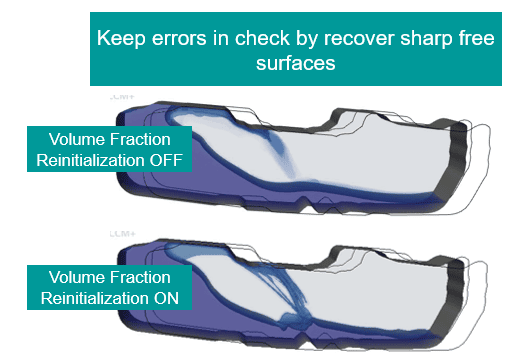Holding strong to the tradition, it is time again for a blog post about multiphase news. This week the latest version of Simcenter STAR-CCM+ was released, version 2306. And as usual the new release is filled with a lot of interesting features, and in this post we will focus on the ones related to Eulerian and Lagrangian multiphase modeling.
Increased stability for industrial EMP cases with coupled momentum interpolation
In a pressure based segregated solver the pressure gradient calculation can lead to checkerboarding. To avoid this phenomenon Rhie-Chow interpolation is used. In Simcenter STAR-CCM+ we have until now had access to the standard form of that interpolation. A problem with that is, and has been, that it is derived for single phase and does not account for the effect of coupling between phases due to drag. The new “Coupled Rhie-Chow” method accounts for this extra coupling which provides much better convergence and stability for multiphase flow. This is extra useful where a strong coupling exists between phases. So, where you previously were forced to deal with strong coupling between phases with user field functions, this new method can now help.
The method will in the end produce the same solution as before, but the way to reach this solution should be faster and more stable. The increased stability will also allow for more aggressive simulation methods with higher URF:s, larger timesteps and reduced number of inner iterations.
The example below shows a case that previously was very difficult to run. An aerated vessel where gas is introduced at the center and then diffused by the action of the impeller. Comparing the old and new method, we can see that convergence is much more stable and results are much more physical.

MHRIC Variable compression and Volume fraction reinitialization for VOF
The introduction of the Modified High resolution Interface Capture (MHIRC) scheme for convection was introduced some time ago now. In this version the flexibility has been increased further, allowing for the sharpness to be adjusted via the Downwind limit parameter. To obtain a result with a sharp interface which corresponds to the previous HRIC settings the parameter should be set to 0.25. The default value is now at 0.5 to correspond to MHRIC. Using a value like 0.75 will give a smeared interface. A value below 0.1 may lead to issues with robustness. User can specify any value between 0 and 1, but most cases should be possible to solve between 0.1 and 0.5. The below figures show the results for a sloshing tank with a varying value for the parameter.
The parameter can also be varied over time to speed up simulations where flow takes time to develop. It should be noted that reducing the value of the parameter will not sharpen previously smeared free surfaces.
The other new feature that can potentially help out with the smeared interface is Volume Fraction Reinitialization. Where the interface is on its way to become to smeared this feature will use aggressive methods to recalculate the interface and reinitialize it. It is activated in a similar fashion to AMR, where you set the update frequency. The update should not be used too frequently (at least not every timestep), and the method should be considered a periodic correction rather than part of the solution.

Zonal approach for ADIS scheme in EMP-LSI
The capability of EMP-LSI has been given further consideration by the possibility to choose the location of the activity of the HRIC. What the EMPS-LSI does is that it utilizes Adaptive interface sharpening (ADIS) that detects where a sharp interface exists and applies HRIC to those locations only. This method comes with the risk of applying a Large scale interface in under-resolved regions as well as in well resolved regions. In under resolved regions the use of HRIC might not be appropriate. The introduction of Primary criterion of Interface Detection (C1) will allow you to spatially disable the use of the HRIC scheme in such locations. In the below example the pipe connecting two larger chambers, have the HRIC disabled.

Updated size distribution sampling algorithm for surface, part, and table injectors
This improvement will provide faster Lagrangian simulations due to the reduced number of parcels needed to achieve target particle size distribution. If an injector has multiple injection points, before we needed to increase the “Parcel stream” setting to 100 or more, to properly describe a distribution for the injector. In version 2306 the distribution is applied to part injection points in addition to the number of parcel streams at each injection point, resulting in improved accuracy of the distribution. The animation below shows how 2302 generates a lower quality of size distributions and the improvement in 2306.
Optimized random injector for mesh-based DEM
The injection algorithm has been updated for the Random injector simulating DEM particles. This change is beneficial for cases that run a large number of particles in the first timestep. The animation shows the result of simulating the same drum dryer application, first in version 2302, and afterwards in version 2306. All hundred thousand particles are injected in the first timestep. In this case the simulation in version 2306 runs 1.4 times faster.
I hope this has been useful to you as a multiphase model user in Simcenter STAR-CCM+. There are a couple of additional updates, but those can be found in the documentation. Additional questions you might have can be sent to support@volupe.com.
Author

Robin Victor
+46731473121
support@volupe.com



